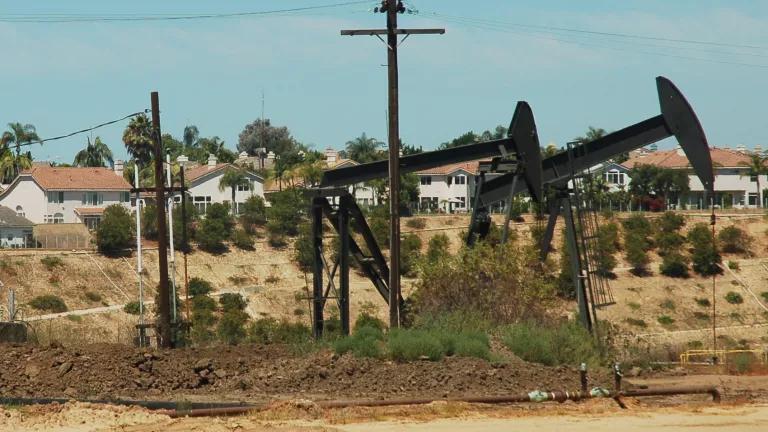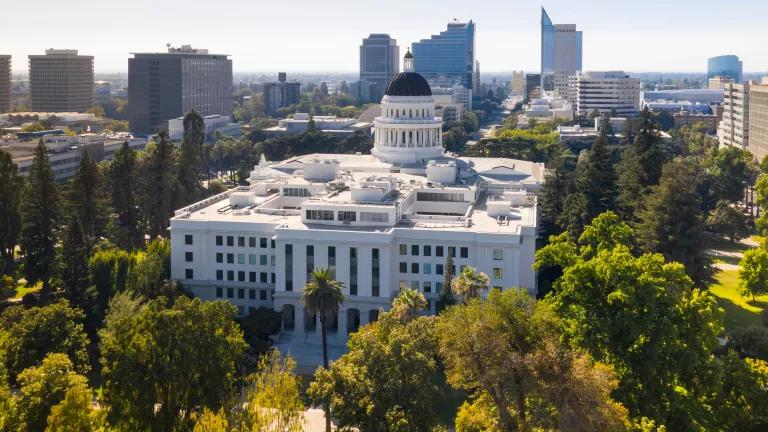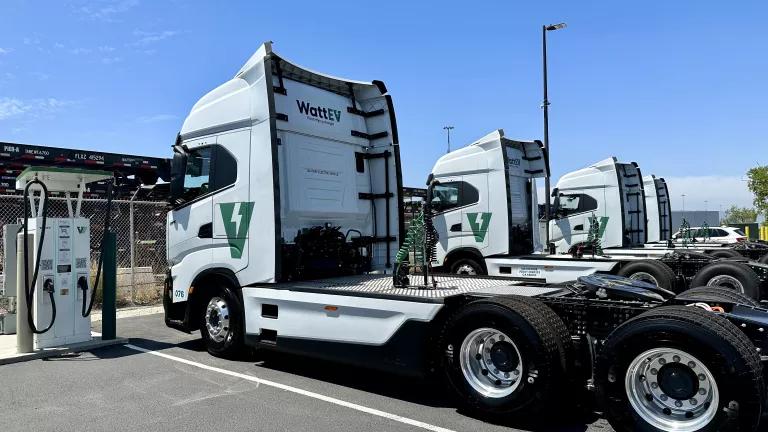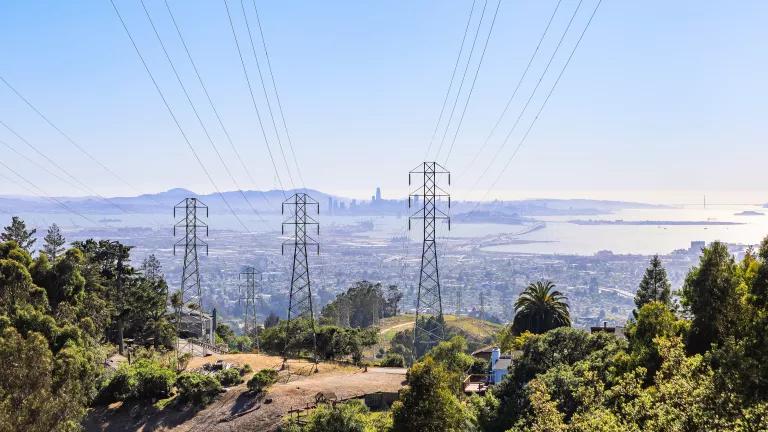
Oil drilling in the Baldwin Hills neighborhood of South Los Angeles. Photo: NRDC
Governor Newsom has been hinting for awhile now at plans to go where no predecessor has gone before: reining in California’s behemoth oil industry. Now, he is no longer hinting. In a news release yesterday morning, the Department of Conservation announced a moratorium on cyclic steaming, the carbon intense and horrifically messy practice responsible for multiple Kern County spills; an independent scientific review of fracking permits; and a public process to develop regulations that better protect the public and the state’s natural resources from drilling operations. These are bold and significant steps toward a more rational approach to oil extraction.
These steps will not, obviously, solve all of the problems associated with California’s deeply entrenched century-old oil industry, or make it go away. When you’re the seventh largest oil producing state in the nation and its biggest gasoline consumer, you can’t shut off the tap in a day. But the administration’s announcement represents a set of well thought out actions that start putting Californians’ health, safety, and environment ahead of the needs of the oil industry. NRDC has been calling for years for a culture shift of this nature in the Department of Conservation, and now we finally have leadership at the top to insist that it happen.
The administration’s actions are in keeping with the concept of a managed decline in oil production, which the governor has been alluding to recently. The idea is that we should not only address the fallout from the decline that’s already happening (we were the third largest oil producer a few years ago), but also make sure that the most harmful production is taken offline first. Accordingly, the announcement contains three separate actions geared to tackle, in different ways, the most problematic aspects of California production.
First, there is a partial moratorium on “high pressure cyclic steaming,” applicable to certain fields where the danger of environmental damage is particularly high. Cyclic steaming is the most problematic method of oil drilling you’ve never heard of. If you’re worried about the massive environmental destruction wrought by Canadian tar sands extraction – as well you should be – you should also be worried about cyclic steaming, which is roughly the same process and accounts for more than half of California’s production. Both types of production involve, in the simplest terms, forcing heavy crude oil the consistency of peanut butter out of the ground by melting it with steam, which is usually generated by combusting fossil fuels. The result is not only a huge carbon footprint – from both the steam production and energy-intense heavy crude refining – but frequent spills when water mixed with crude is forced to the surface by this high-pressure process.
There is no better way to start managing California’s decline than managing cyclic steaming out of existence. The announcement did not say how long the moratorium on this practice will last, but states that in the end, “oil and gas regulators could require certain safety practices, update regulations to impose new rules, or prohibit the practice altogether.” We are very much rooting for the latter. We are also hoping the administration will broaden the moratorium to include all cyclic steaming in California.
Second, the administration has called in experts from the Lawrence Livermore National Laboratory to conduct a scientific review of fracking permit applications. One might call this a soft moratorium. There’s no clear statement – as there is with regard to cyclic steaming – that the Department of Conservation is calling a halt to issuance of fracking permits during this process, but it’s somewhat evident between the lines that that’s the likely impact. The announcement acknowledges the fracking permit process has been “under review” since July 2019 – roughly when the Governor fired the former supervisor of oil production operations amidst a conflict of interest scandal. In any case, it’s a welcome next step to build on the fracking regulations promulgated based on 2013’s SB4 – which resulted in a short term reduction in fracking permits followed by a rebound in recent years. A second look makes good sense now that the regulatory process has been up and running for awhile.
And third, the administration will be conducting a rulemaking process to tighten up standards governing production, which sounds as though it will be significantly grounded in public input. The announcement promises listening sessions with communities (“pre-rulemaking workshops with interested parties to seek input on the best ways to protect human health through new rules”), and “pro-active outreach” to community leaders and stakeholders.
The rulemaking portion explicitly puts on the table a policy measure that we view as central and essential to protecting communities most directly affected by drilling: “prohibiting oil and gas activities within close proximity of homes, schools, hospitals, and parks.” For all of the oil industry’s silly insistence that they are governed by “the toughest environmental protections in the world,” California is almost alone among oil producing states in lacking a statewide setback requirement for oil wells. Unless a local government steps in to establish a setback, operators can and do plunk oil wells down right next to where people live and go to school.
There really isn’t a question anymore that proximity to oil production is a significant health hazard. The process generates all manner of hazardous air contaminants, among other things; and living next to it has been correlated with a risk of birth defects, low birth weight, cancer, and respiratory and dermal impacts. The setbacks in other states aren’t nearly adequate to address these health risks. They are generally a few hundred feet, whereas California activists have been looking at the health studies and calling for a setback of 2,500 feet, and backing a legislative proposal to achieve that. The administration’s announcement gives California an opportunity to turn itself into a leader rather than a laggard in this area.
2020 promises to be an exciting year as we work with the state and our coalition partners to hammer out protections for communities affected by oil production. In the long run, of course, managing the production decline is going to require a lot more than tougher regulations. We need to look at transitioning fossil fuel jobs, and figure out how to support communities whose local economies have been dependent on oil revenues. We also need to take aggressive measures to reduce our demand for oil. California may be only the seventh largest producer of oil, but it is the number one consumer of gasoline – 366 million barrels in 2017, as the LA Times pointed out in its story on yesterday’s announcement. Fortunately, the administration is working on a study of “strategies to reduce the supply and demand for fossil fuels” in California. The study will provide an opportunity to correlate oil demand reduction strategies with curbs on production.
All in all, the administration’s announcement represents a welcome follow-up to the suite of oil and gas regulatory bills signed by the governor last month. While we were disappointed that those bills did not include AB 1440, which would have created an explicit mandate for the oil and gas supervisor to prioritize health and the environment over the needs of industry, the administration appears headed in that direction regardless. The dream of a fossil-free California is one step closer to reality this week than it was last week, and for that we’re glad.




